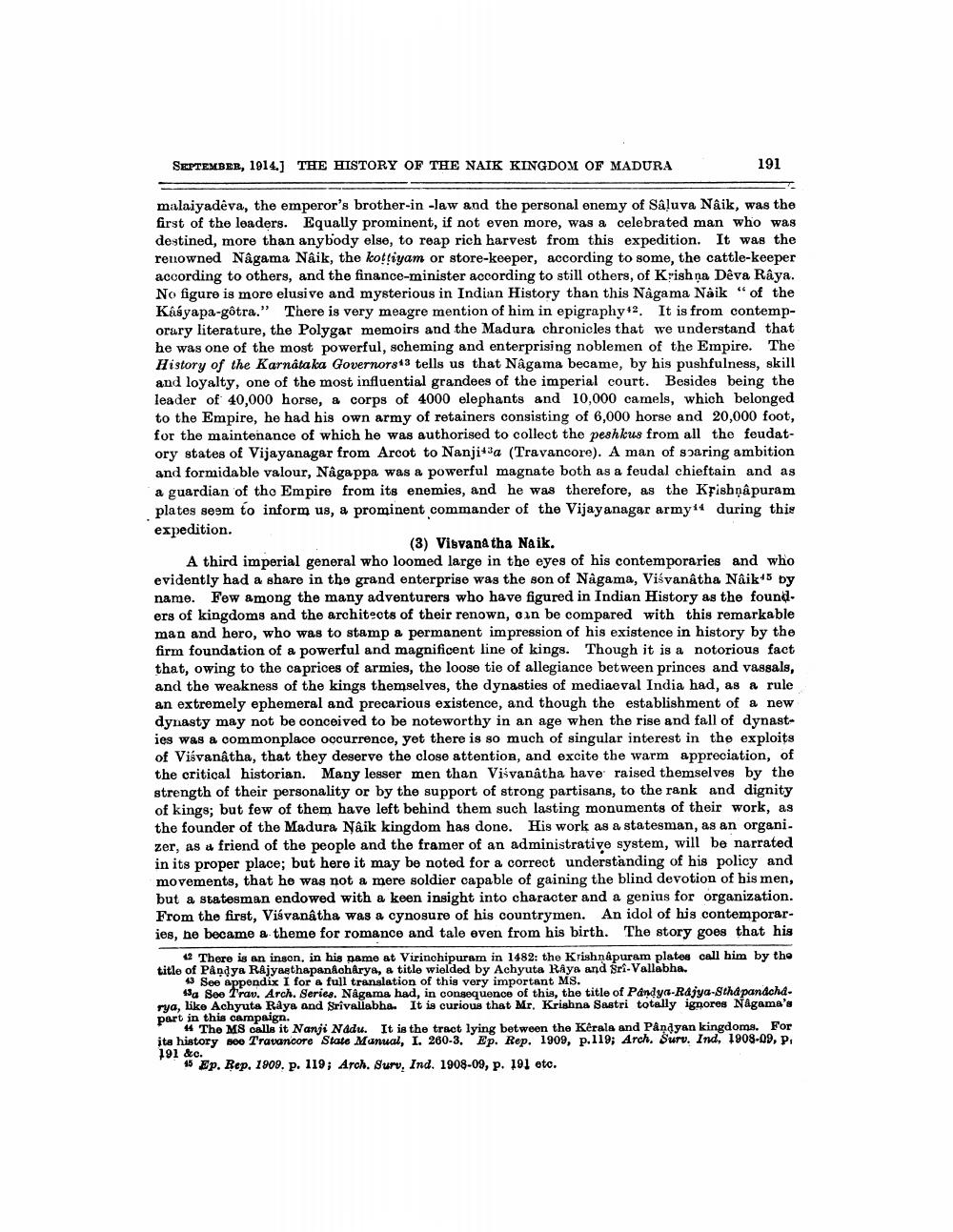________________
SEPTEMBER, 1914.] THE HISTORY OF THE NAIK KINGDOM OF MADURA
191
malaiyadeva, the emperor's brother-in-law and the personal enemy of Saluva Naik, was the first of the leaders. Equally prominent, if not even more, was a celebrated man who was destined, more than anybody else, to reap rich harvest from this expedition. It was the renowned Nâgama Naik, the kottiyam or store-keeper, according to some, the cattle-keeper according to others, and the finance-minister according to still others, of Krishna Dêva Râya. No figure is more elusive and mysterious in Indian History than this Nagama Naik " of the Kasyapa-gôtra." There is very meagre mention of him in epigraphy+2. It is from contemporary literature, the Polygar memoirs and the Madura chronicles that we understand that he was one of the most powerful, scheming and enterprising noblemen of the Empire. The History of the Karnataka Governors 3 tells us that Nâgama became, by his pushfulness, skill and loyalty, one of the most influential grandees of the imperial court. Besides being the leader of 40,000 horse, a corps of 4000 elephants and 10,000 camels, which belonged to the Empire, he had his own army of retainers consisting of 6,000 horse and 20,000 foot, for the maintenance of which he was authorised to collect the peshkus from all the feudatory states of Vijayanagar from Arcot to Nanji-ja (Travancore). A man of soaring ambition and formidable valour, Nâgappa was a powerful magnate both as a feudal chieftain and as a guardian of the Empire from its enemies, and he was therefore, as the Krishnapuram plates seem to inform us, a prominent commander of the Vijayanagar army during this expedition.
(3) Visvana tha Naik. A third imperial general who loomed large in the eyes of his contemporaries and who evidently had a share in the grand enterprise was the son of Nagama, Visvanatha Naiks by name. Few among the many adventurers who have figured in Indian History as the found. ers of kingdoms and the architects of their renown, oin be compared with this remarkable man and hero, who was to stamp a permanent impression of his existence in history by the firm foundation of a powerful and magnificent line of kings. Though it is a notorious fact that, owing to the caprices of armies, the loose tie of allegiance between princes and vassals, and the weakness of the kings themselves, the dynasties of mediaeval India had, as a rule an extremely ephemeral and precarious existence, and though the establishment of a new dynasty may not be conceived to be noteworthy in an age when the rise and fall of dynasties was a commonplace occurrence, yet there is so much of singular interest in the exploits of Visvanatha, that they deserve the close attention, and excite the warm appreciation, of the critical historian. Many lesser men than Visvanatha have raised themselves by the strength of their personality or by the support of strong partisans, to the rank and dignity of kings; but few of them have left behind them such lasting monuments of their work, as the founder of the Madura Naik kingdom has done. His work as a statesman, as an organi. zer, as a friend of the people and the framer of an administrative system, will be narrated in its proper place; but here it may be noted for a correct understanding of his policy and movements, that he was not a mere soldier capable of gaining the blind devotion of his men, but a statesman endowed with a keen insight into character and a genius for organization. From the first, Visvanatha was a cynosure of his countrymen. An idol of his contemporaries, he became a theme for romance and tale even from his birth. The story goes that his
12 There is an inson, in his namo at Virinchipuram in 1482: the Krishnapuram plates call him by the title of Påndya Rajyaethapan oharya, a title wielded by Achyuta Raya and Sri Vallabha.
13 See appendix I for a full translation of this very important MS.
130 Soo I'rav. Arch. Series. Nagama had, in consequence of this, the title of Pandya-Rajya-Sthd pandchdrya, kike Achyuta Raya and Srivallabha. It is curious that Mr. Krishna Sastri totally ignores Nagama's part in this campaign.
4 The MS calls it Nanji Nadu. It is the tract lying between the Kerala and Pandyan kingdoms. For ita history soo Travancore State Manual, I. 260-3. Ep. Rep. 1909, p. 119; Arch. Surv. Ind, 1908-09, P. 191 &c.
45 Ep. Rep. 1909. p. 119; Arch. Surv, Ind. 1908-09, p. 191 etc.




